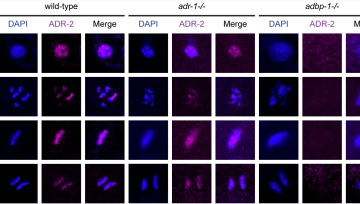POTLIGHT ON RESEARCH
PAPER OF THE MONTH JUNE 2024
The Committee for Graduate Studies in the Faculty of Biology selects the leading scientific article each month from all the scientific articles published for that month.
We are pleased to announce that the winner of June’s article 2024 is Berta Eliad from Prof. Ayelet Lamm Lab whose article was published in Nucleic Acids Research. On the occasion of the win, we asked her to provide us with some interesting details about the study, the path that led to the research, and a bit about her.
- Hi, could you introduce yourself in a few words?
I am a PhD student in Ayelet Lam’s lab and a bioinformatician. I completed my bachelor’s degree in biology at Tel Aviv University. I am on the direct PhD track in Ayelet’s lab and manage the lab’s programming team.
- Could you explain what Prof. Lamm Laboratory is all about?
The lab studies epigenetic processes essential for genome dynamics during development and cell differentiation. Most of the research is focused on one of the metazoans’ most common editing mechanisms – A-to-I RNA editing. In this mechanism, adenosine is deaminated to inosine in double-stranded RNA. This small change in the RNA sequence significantly affects the cell’s creation of new proteins and gene regulation. Our model organism is the nematode C. elegans, where, unlike in mammals, the absence of this mechanism is not lethal, allowing us to understand what happens to the cell and the whole organism in the absence of RNA editing.
- Could you tell us about your current article/research what was the main purpose of the research and what did you discover?
In the current study, we aimed to understand where in the cell the ADR-2 protein, which deaminates adenosine to inosine in the nematode, is located and to determine whether the editing occurs in the nucleus or the cytoplasm. Additionally, we wanted to find out if ADR-2 is expressed in all C.elegans tissues or only in specific ones. We discovered that the ADR-2 protein is localized in the nucleus and near the chromosomes throughout all cell cycle stages. Furthermore, ADR-2 is not expressed everywhere in the nematode; it is present in oocytes and embryos but not in sperm. In the head, body, and tail of the nematode, only some cells express it. ADR-2 enters the nucleus with the help of another protein called ADBP-1. When ADBP-1 is non-functional, ADR-2 is also found in the cytoplasm and, surprisingly, is functional there. While in the nucleus, most editing is regulated and occurs in introns, in the cytoplasm, it edits double-stranded RNA randomly, primarily in exons.
Additionally, we discovered the preferences of the ADR-2 protein. ADR-2 prefers to act on double-stranded RNA with a stable secondary structure. Along the gene itself, it prefers to edit adenosines surrounded by specific neighboring nucleotides, which differ in their identity across different parts of the gene: introns, exons, or UTRs.
- Can you elaborate on the importance of the discovery? How will it serve you and what directions does it take? What is the application of the discovery (domains, solutions)?
Our discoveries allow us to understand better the A-to-I RNA editing mechanism, how and where ADR-2 acts, and its preferences. These findings bring us closer to comprehending the overall role of A-to-I RNA editing. Currently, efforts are being made to develop gene therapy through adenosine-to-inosine editing, and we hope that our discoveries will contribute to this endeavor.
- Name 3 prominent tools that you received in the laboratory during your work and studies?
One of the main things that was strengthened in me during my PhD is my ability to learn from scratch entirely on my own. I taught myself programming and bioinformatics work, and I enjoyed it very much. Another skill I gained in the lab and during my studies is critical thinking, which is essential for research and life in general. Additionally, Ayelet allowed me to manage the lab’s bioinformatics team, which includes undergraduate programmers, thus developing my management skills.
- When you are not “doing” science, what do you do?
When not doing science, I mainly spend time with my terrific three children and my husband, Saar. When I have free time, I enjoy reading books.
- What are your plans for the future of your career?
My immediate goal is to pursue a postdoctoral fellowship after completing my degree.
➡ A link to the full article: https://academic.oup.com/nar/advance-article/doi/10.1093/nar/gkae641/7717836
➡ A link to the Lamm lab site: https://lammlab.net.technion.ac.il/
➡ To Assistant Prof. Lamm’s page: https://biology.technion.ac.il/member/%D7%9C%D7%9D/
Images from right to left:
On the left a summary of the article’s findings: The ADR-2 protein, responsible for RNA editing, is expressed in embryos, oocytes, and some cells in the head, body, and tail of the worm, but not in sperm. The ADBP-1 protein is responsible for the presence of ADR-2 in the nucleus, where it edits introns. In the middle, ADR-2 is found near chromosomes throughout cell division. On the right, in the absence of ADBP-1, ADR-2 is located in the nucleus, where it primarily edits exons in random genes but prefers to edit adenosines with specific neighboring nucleotides across different parts of the gene.












